Ziming Hong
Prototype-Guided Curriculum Learning for Zero-Shot Learning
Aug 11, 2025Abstract:In Zero-Shot Learning (ZSL), embedding-based methods enable knowledge transfer from seen to unseen classes by learning a visual-semantic mapping from seen-class images to class-level semantic prototypes (e.g., attributes). However, these semantic prototypes are manually defined and may introduce noisy supervision for two main reasons: (i) instance-level mismatch: variations in perspective, occlusion, and annotation bias will cause discrepancies between individual sample and the class-level semantic prototypes; and (ii) class-level imprecision: the manually defined semantic prototypes may not accurately reflect the true semantics of the class. Consequently, the visual-semantic mapping will be misled, reducing the effectiveness of knowledge transfer to unseen classes. In this work, we propose a prototype-guided curriculum learning framework (dubbed as CLZSL), which mitigates instance-level mismatches through a Prototype-Guided Curriculum Learning (PCL) module and addresses class-level imprecision via a Prototype Update (PUP) module. Specifically, the PCL module prioritizes samples with high cosine similarity between their visual mappings and the class-level semantic prototypes, and progressively advances to less-aligned samples, thereby reducing the interference of instance-level mismatches to achieve accurate visual-semantic mapping. Besides, the PUP module dynamically updates the class-level semantic prototypes by leveraging the visual mappings learned from instances, thereby reducing class-level imprecision and further improving the visual-semantic mapping. Experiments were conducted on standard benchmark datasets-AWA2, SUN, and CUB-to verify the effectiveness of our method.
Jailbreaking the Non-Transferable Barrier via Test-Time Data Disguising
Mar 21, 2025Abstract:Non-transferable learning (NTL) has been proposed to protect model intellectual property (IP) by creating a "non-transferable barrier" to restrict generalization from authorized to unauthorized domains. Recently, well-designed attack, which restores the unauthorized-domain performance by fine-tuning NTL models on few authorized samples, highlights the security risks of NTL-based applications. However, such attack requires modifying model weights, thus being invalid in the black-box scenario. This raises a critical question: can we trust the security of NTL models deployed as black-box systems? In this work, we reveal the first loophole of black-box NTL models by proposing a novel attack method (dubbed as JailNTL) to jailbreak the non-transferable barrier through test-time data disguising. The main idea of JailNTL is to disguise unauthorized data so it can be identified as authorized by the NTL model, thereby bypassing the non-transferable barrier without modifying the NTL model weights. Specifically, JailNTL encourages unauthorized-domain disguising in two levels, including: (i) data-intrinsic disguising (DID) for eliminating domain discrepancy and preserving class-related content at the input-level, and (ii) model-guided disguising (MGD) for mitigating output-level statistics difference of the NTL model. Empirically, when attacking state-of-the-art (SOTA) NTL models in the black-box scenario, JailNTL achieves an accuracy increase of up to 55.7% in the unauthorized domain by using only 1% authorized samples, largely exceeding existing SOTA white-box attacks.
Toward Robust Non-Transferable Learning: A Survey and Benchmark
Feb 19, 2025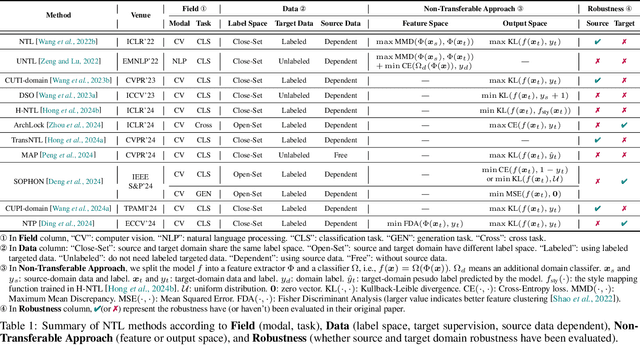
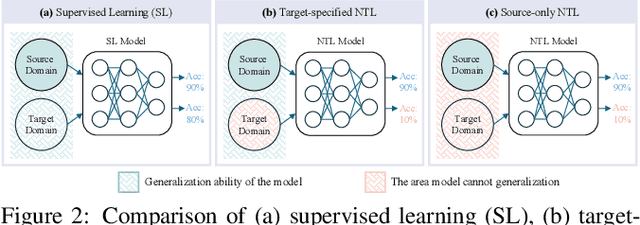

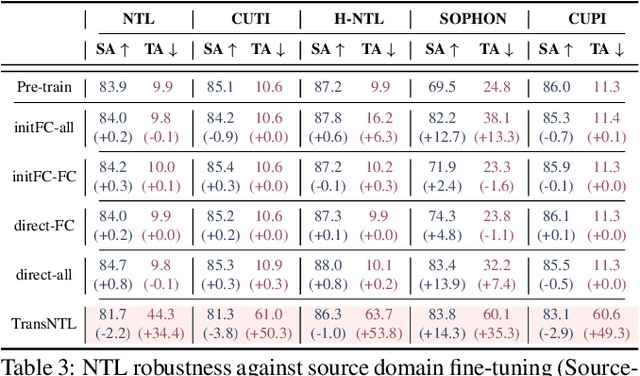
Abstract:Over the past decades, researchers have primarily focused on improving the generalization abilities of models, with limited attention given to regulating such generalization. However, the ability of models to generalize to unintended data (e.g., harmful or unauthorized data) can be exploited by malicious adversaries in unforeseen ways, potentially resulting in violations of model ethics. Non-transferable learning (NTL), a task aimed at reshaping the generalization abilities of deep learning models, was proposed to address these challenges. While numerous methods have been proposed in this field, a comprehensive review of existing progress and a thorough analysis of current limitations remain lacking. In this paper, we bridge this gap by presenting the first comprehensive survey on NTL and introducing NTLBench, the first benchmark to evaluate NTL performance and robustness within a unified framework. Specifically, we first introduce the task settings, general framework, and criteria of NTL, followed by a summary of NTL approaches. Furthermore, we emphasize the often-overlooked issue of robustness against various attacks that can destroy the non-transferable mechanism established by NTL. Experiments conducted via NTLBench verify the limitations of existing NTL methods in robustness. Finally, we discuss the practical applications of NTL, along with its future directions and associated challenges.
Visual-Augmented Dynamic Semantic Prototype for Generative Zero-Shot Learning
Apr 23, 2024



Abstract:Generative Zero-shot learning (ZSL) learns a generator to synthesize visual samples for unseen classes, which is an effective way to advance ZSL. However, existing generative methods rely on the conditions of Gaussian noise and the predefined semantic prototype, which limit the generator only optimized on specific seen classes rather than characterizing each visual instance, resulting in poor generalizations (\textit{e.g.}, overfitting to seen classes). To address this issue, we propose a novel Visual-Augmented Dynamic Semantic prototype method (termed VADS) to boost the generator to learn accurate semantic-visual mapping by fully exploiting the visual-augmented knowledge into semantic conditions. In detail, VADS consists of two modules: (1) Visual-aware Domain Knowledge Learning module (VDKL) learns the local bias and global prior of the visual features (referred to as domain visual knowledge), which replace pure Gaussian noise to provide richer prior noise information; (2) Vision-Oriented Semantic Updation module (VOSU) updates the semantic prototype according to the visual representations of the samples. Ultimately, we concatenate their output as a dynamic semantic prototype, which serves as the condition of the generator. Extensive experiments demonstrate that our VADS achieves superior CZSL and GZSL performances on three prominent datasets and outperforms other state-of-the-art methods with averaging increases by 6.4\%, 5.9\% and 4.2\% on SUN, CUB and AWA2, respectively.
Evolving Semantic Prototype Improves Generative Zero-Shot Learning
Jun 12, 2023



Abstract:In zero-shot learning (ZSL), generative methods synthesize class-related sample features based on predefined semantic prototypes. They advance the ZSL performance by synthesizing unseen class sample features for better training the classifier. We observe that each class's predefined semantic prototype (also referred to as semantic embedding or condition) does not accurately match its real semantic prototype. So the synthesized visual sample features do not faithfully represent the real sample features, limiting the classifier training and existing ZSL performance. In this paper, we formulate this mismatch phenomenon as the visual-semantic domain shift problem. We propose a dynamic semantic prototype evolving (DSP) method to align the empirically predefined semantic prototypes and the real prototypes for class-related feature synthesis. The alignment is learned by refining sample features and semantic prototypes in a unified framework and making the synthesized visual sample features approach real sample features. After alignment, synthesized sample features from unseen classes are closer to the real sample features and benefit DSP to improve existing generative ZSL methods by 8.5\%, 8.0\%, and 9.7\% on the standard CUB, SUN AWA2 datasets, the significant performance improvement indicates that evolving semantic prototype explores a virgin field in ZSL.
MSDN: Mutually Semantic Distillation Network for Zero-Shot Learning
Mar 07, 2022



Abstract:The key challenge of zero-shot learning (ZSL) is how to infer the latent semantic knowledge between visual and attribute features on seen classes, and thus achieving a desirable knowledge transfer to unseen classes. Prior works either simply align the global features of an image with its associated class semantic vector or utilize unidirectional attention to learn the limited latent semantic representations, which could not effectively discover the intrinsic semantic knowledge e.g., attribute semantics) between visual and attribute features. To solve the above dilemma, we propose a Mutually Semantic Distillation Network (MSDN), which progressively distills the intrinsic semantic representations between visual and attribute features for ZSL. MSDN incorporates an attribute$\rightarrow$visual attention sub-net that learns attribute-based visual features, and a visual$\rightarrow$attribute attention sub-net that learns visual-based attribute features. By further introducing a semantic distillation loss, the two mutual attention sub-nets are capable of learning collaboratively and teaching each other throughout the training process. The proposed MSDN yields significant improvements over the strong baselines, leading to new state-of-the-art performances on three popular challenging benchmarks, i.e., CUB, SUN, and AWA2. Our codes have been available at: \url{https://github.com/shiming-chen/MSDN}.
TransZero++: Cross Attribute-Guided Transformer for Zero-Shot Learning
Dec 21, 2021



Abstract:Zero-shot learning (ZSL) tackles the novel class recognition problem by transferring semantic knowledge from seen classes to unseen ones. Existing attention-based models have struggled to learn inferior region features in a single image by solely using unidirectional attention, which ignore the transferability and discriminative attribute localization of visual features. In this paper, we propose a cross attribute-guided Transformer network, termed TransZero++, to refine visual features and learn accurate attribute localization for semantic-augmented visual embedding representations in ZSL. TransZero++ consists of an attribute$\rightarrow$visual Transformer sub-net (AVT) and a visual$\rightarrow$attribute Transformer sub-net (VAT). Specifically, AVT first takes a feature augmentation encoder to alleviate the cross-dataset problem, and improves the transferability of visual features by reducing the entangled relative geometry relationships among region features. Then, an attribute$\rightarrow$visual decoder is employed to localize the image regions most relevant to each attribute in a given image for attribute-based visual feature representations. Analogously, VAT uses the similar feature augmentation encoder to refine the visual features, which are further applied in visual$\rightarrow$attribute decoder to learn visual-based attribute features. By further introducing semantical collaborative losses, the two attribute-guided transformers teach each other to learn semantic-augmented visual embeddings via semantical collaborative learning. Extensive experiments show that TransZero++ achieves the new state-of-the-art results on three challenging ZSL benchmarks. The codes are available at: \url{https://github.com/shiming-chen/TransZero_pp}.
TransZero: Attribute-guided Transformer for Zero-Shot Learning
Dec 03, 2021



Abstract:Zero-shot learning (ZSL) aims to recognize novel classes by transferring semantic knowledge from seen classes to unseen ones. Semantic knowledge is learned from attribute descriptions shared between different classes, which act as strong priors for localizing object attributes that represent discriminative region features, enabling significant visual-semantic interaction. Although some attention-based models have attempted to learn such region features in a single image, the transferability and discriminative attribute localization of visual features are typically neglected. In this paper, we propose an attribute-guided Transformer network, termed TransZero, to refine visual features and learn attribute localization for discriminative visual embedding representations in ZSL. Specifically, TransZero takes a feature augmentation encoder to alleviate the cross-dataset bias between ImageNet and ZSL benchmarks, and improves the transferability of visual features by reducing the entangled relative geometry relationships among region features. To learn locality-augmented visual features, TransZero employs a visual-semantic decoder to localize the image regions most relevant to each attribute in a given image, under the guidance of semantic attribute information. Then, the locality-augmented visual features and semantic vectors are used to conduct effective visual-semantic interaction in a visual-semantic embedding network. Extensive experiments show that TransZero achieves the new state of the art on three ZSL benchmarks. The codes are available at: \url{https://github.com/shiming-chen/TransZero}.
View Vertically: A Hierarchical Network for Trajectory Prediction via Fourier Spectrums
Oct 14, 2021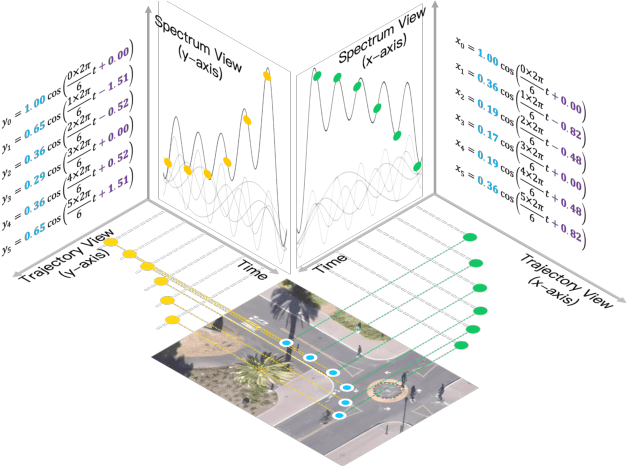
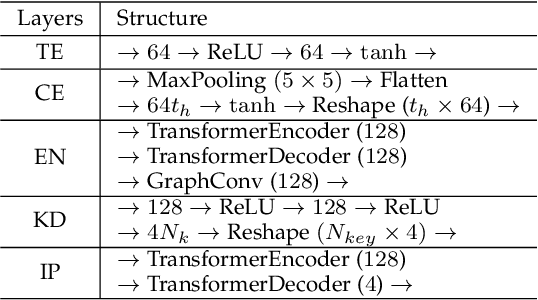

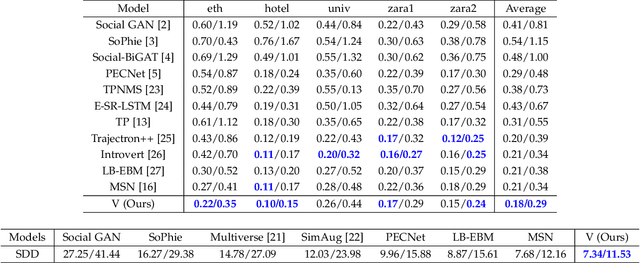
Abstract:Learning to understand and predict future motions or behaviors for agents like humans and robots are critical to various autonomous platforms, such as behavior analysis, robot navigation, and self-driving cars. Intrinsic factors such as agents' diversified personalities and decision-making styles bring rich and diverse changes and multi-modal characteristics to their future plannings. Besides, the extrinsic interactive factors have also brought rich and varied changes to their trajectories. Previous methods mostly treat trajectories as time sequences, and reach great prediction performance. In this work, we try to focus on agents' trajectories in another view, i.e., the Fourier spectrums, to explore their future behavior rules in a novel hierarchical way. We propose the Transformer-based V model, which concatenates two continuous keypoints estimation and spectrum interpolation sub-networks, to model and predict agents' trajectories with spectrums in the keypoints and interactions levels respectively. Experimental results show that V outperforms most of current state-of-the-art methods on ETH-UCY and SDD trajectories dataset for about 15\% quantitative improvements, and performs better qualitative results.
 Add to Chrome
Add to Chrome Add to Firefox
Add to Firefox Add to Edge
Add to Edge